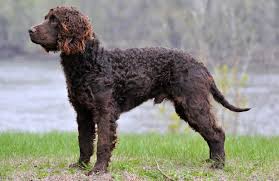
Tweed Water Spaniel
Conditions of detention
Tweed Water Spaniels were well-suited to rural environments where they had access to water and open spaces for exercise and hunting. They thrived in settings that allowed them to engage in their natural retrieving and swimming behaviors.
Useful Fact:
These dogs excelled in environments with water access, as their skills in retrieving game from water were highly valued by hunters.
Nutrition and diet
A balanced diet rich in protein would have been essential for the Tweed Water Spaniel to support its active lifestyle. They likely consumed a diet similar to other working dogs of the time, consisting of meat, grains, and other available food sources.
Useful Fact:
Feeding a diet that supports their energy levels and muscle maintenance would have been crucial given their physically demanding role.
Health
Specific health issues of the Tweed Water Spaniel are not well-documented, but like other water dogs, they may have been prone to ear infections due to frequent exposure to water.
Useful Fact:
Regular ear care would have been important to prevent infections and ensure their ability to work effectively in water.
Grooming and care
The Tweed Water Spaniel had a curly, water-resistant coat that required regular grooming to prevent matting and to remove loose hair. Grooming would have been essential to maintain their coat’s functionality and health.
Useful Fact:
Their coat was an asset for working in wet conditions, providing insulation and protection while retrieving in water.
Education and training
Tweed Water Spaniels were intelligent and trainable, making them excellent working dogs. Training would have focused on developing their natural retrieving instincts and obedience.
Useful Fact:
Their eagerness to please and work alongside humans made them cooperative and reliable partners in hunting.
Toys and entertainment
These dogs would have enjoyed activities that engaged their natural retrieving and swimming abilities. Training exercises and hunting activities would have served as their primary forms of entertainment.
Useful Fact:
Providing them with tasks that mimic their working roles would have kept them mentally and physically stimulated.
Safety
Safety measures for Tweed Water Spaniels would have included monitoring their time in the water to prevent overexertion and ensuring they were not exposed to hazardous conditions.
Useful Fact:
Despite their proficiency in water, ensuring safe swimming conditions and rest periods would have been important for their well-being.
Accessories
Collars and leashes for managing the Tweed Water Spaniel during hunting and training would have been essential, alongside any necessary equipment for retrieving game.
Useful Fact:
Proper equipment would have facilitated their role in retrieving and ensured effective management during work.
Socialization
Tweed Water Spaniels were social dogs that worked closely with humans and other dogs. Socialization would have been important to ensure they were comfortable and effective in various working environments.
Useful Fact:
Their role required them to be adaptable and friendly, capable of working alongside hunters and other dogs.
Travel and Transportation
Tweed Water Spaniels would have been accustomed to traveling to different hunting locations. Ensuring they had secure transportation would have been important for their safety and comfort.
Useful Fact:
Traveling with hunters allowed them to explore different terrains and waters, enhancing their versatility as working dogs.
Behavior and psychology
The Tweed Water Spaniel was known for its intelligence, loyalty, and strong retrieving instincts. These dogs formed close bonds with their handlers and were dedicated to their work.
Useful Fact:
Their cooperative nature and eagerness to retrieve made them invaluable assets in hunting and retrieving game.
Legal aspects
There were no specific legal regulations governing the ownership or use of Tweed Water Spaniels, as they were primarily working dogs valued for their skills.
Useful Fact:
Their role as working dogs exempted them from many of the considerations given to pet dogs, reflecting the different cultural attitudes toward animals at the time.


